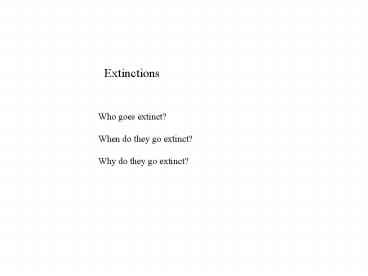Extinctions - PowerPoint PPT Presentation
Title:
Extinctions
Description:
Mammals replaced dinosaurs. Lineage replacement may be either passive or competitive ... dinosaurs, mammals. bivalves, brachiopods are an example of ... – PowerPoint PPT presentation
Number of Views:40
Avg rating:3.0/5.0
Title: Extinctions
1
Extinctions
Who goes extinct? When do they go extinct? Why
do they go extinct?
2
47G 16F
82G 51F
57G 22F
53G 22F
60G 26F
50G
3
(No Transcript)
4
(No Transcript)
5
(No Transcript)
6
(No Transcript)
7
(No Transcript)
8
ammonites
9
brachiopods
10
(No Transcript)
11
Importance of Contingency Some Clades
Within a Lineage Do Better Than
Others ammonites P/TR 2 lineages
survive and re-radiate K/T all
extinct Ecological Roles Filled by
Different Lineages e.g., Reefs 550
Cambrian calcified microbes archeocyanthans
(sponge-like) 450 Ordovician bryozoans
stromatoporoids sponges 250
Permian scleractinian corals
???
12
and maybe the end-Permian mass extinction Basu
et al. 2003 Science 3021388
13
What Enhances Survival During a Mass Extinction
Event? Jablonski 1986 Jablonski and Raup 1995
end-Cretaceous most recent, best fossil
record bivalves, gastropods is survival
random ? do traits which enhance survival
during non-mass extinctions also affect survival
during mass extinction events?
14
larval feeding ecology affects background
extinction rates of species
15
long-lived clades have broad geographic ranges
16
body size does not affect the probability of
survival
17
geographically widespread taxa are less likely to
become extinct
18
Contingency plus Opportunity
Mammals replaced dinosaurs
19
Lineage replacement may be either passive or
competitive
one lineage causes the extinction of
another
one lineage becomes extinct, another
radiates
20
angiosperms, conifers horses in NA only
dinosaurs, mammals
bivalves, brachiopods are an example of
competitive replacement enhanced by a mass
extinction event
21
Extinctions Africa/Eurasia Few extinctions.
In Africa ancient In Eurasia mammoths,
mastodons, wooly rhinos Australia
(40,000BP) Essentially all large mammals. 4
large species remained. Giant koalas, giant
(hippo-sized) Diprotodon, giant kangaroos,
giant wombats. 45 large species. 90
extinct. Also giant lizards, tortoises,
snakes and large, flightless birds
22
North/South America (12,000BP) Most
extinguished. Exceptions are also ice age
migrants (deer, puma, bison, caribou, moose,
musk oxen). Mammoths, mastodons, ground
sloths, giant camels, bison, bears, wolves, N.
Am 33 genera S. Am. 46 genera (20 genera in
previous 3 million years) New Zealand
(1000 yrs) Essentially all large species
Moas, giant kiwis, Madagascar (1000
yrs) Essentially all large mammals and birds.
Giant lemurs, Elephant birds
23
loss of large mammals Africa 14 N.
America 73 S. America 79 Australia 86
Extinction happened at different times It is
always soon after the arrival of humans Nobody
else had invaded
24
Humans and extinction Human invasion
associated with widespread extinction post-Pleist
ocene faunas of North America, northern
Eurasia megafauna of Australia Avifauna of
Pacific islands Steadman 1995 Science
2671123 examined bone deposits on 40
Pacific islands bone deposits predate human
colonization by tens of thousands of
years two waves of human colonization Polynesi
ans 1000-3500 yrs bp Europeans 100-300 yrs bp
25
Lanai hookbill
Hawaiian rail
Bishops oo
Black mamo
Moa nalo
Laysan rail
26
(No Transcript)
27
Extinction of the Polynesian avifauna Hawaii
(colonized 500-600 A.D.) endemic
finches (honeycreeepers) flightless ducks,
geese, ibis 60 endemic species extinct
before European arrival 20-25 more
extinctions in the last 200 years New Zealand
(colonized 800-1100 A.D.) endemic
moas, kiwis, waterfowl 44 endemic
species extinct within the last 1000 years
7 more extinctions in the last 200 years
Easter Island (colonized 500-1000 A.D.)
complete deforestation 550 years b.p.
fossil evidence of 2 rails, 1 heron, 2 parrots, 1
owl (all extinct) originally 25-30
nesting seabirds 8-10 species nest only
offshore 13-16 species no longer nest
anywhere nearby 1 species remains nesting on
the main island
28
Galapagos Islands not inhabited until
European discovery in 1535 minor human impact
until 1800 A.D. 0-3 vertebrate species
extinct in 4,000-8,000 years ltlt humans
21-24 extinctions since European discovery and
human settlement
29
Reasons for Polynesian avifaunal
extinction habitat loss human
predation introduced predators (pigs, dogs,
rats, snakes) introduced competitors (goats,
mynahs) introduced pathogens (esp., avian
malaria) Steadman estimates that 10
species/populations lost from each of
the islands (n800) ---gt 8000 species, 2000
species of rails
30
Mass extinctions represent rare events on a
continuum of extinction intensities Lineages
may be lost, may become rare, or may diversify as
a consequence of a mass extinction
event Recovery is characterized by 1)
initial interval of low diversity dominated by
geographically widespread, ecologically
generalist species 2) expansion of
opportunistic species 3) relatively rapid
ecological diversification Because they so
greatly change species composition, subsequent
lineage diversification is not predictable but
is contingent on which clades survive Heterogene
ity in the recovery of molluscan faunas after the
Cretaceous mass extinction may reflect sampling
error or ecological contingency Humans are
producing another mass extinction event, largely
through habitat destruction































